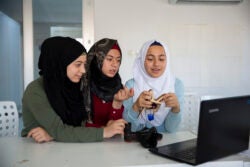In spite of restrictions caused by the coronavirus pandemic, educators learned that online education can work – and that there are opportunities to keep young people connected outside of the classroom. Students working from home may have felt more isolated, but the world was never wider for them to explore in a new way. Trends come and go, but one trend in education that seems to be sticking around is the idea that our students need to be prepared for an ever globalizing and interconnected world. One way many schools are looking at achieving this lofty objective is by adding a global education certificate program to their curriculum. Bringing virtual exchange into these programs can enrich the curriculum and better prepare students for the future.

The nice thing about these global education certificate programs is their versatility: they can be localized to a single school, tailored to an individual district, or more broadly defined by their state. The benefits of participating in these programs are numerous for both the students participating and the future of our society. Students that participate in global education certificates enter the world more prepared to take perspectives of their peers, effectively communicate with diverse audiences, question the status quo, and take action to improve our world.
Global education certificate requirements vary, but most align in certain areas: global coursework, service learning, participation in multicultural events, and language learning. Virtual exchange is the perfect way to incorporate these areas into a global education certificate curriculum. Virtual exchange programs provide high-quality, accessible global learning opportunities to classrooms around the world. Virtual exchange programs provide so many spaces for learning, both in the classroom and as extracurricular opportunities. Such programs are not designed to replace or hinder the already ongoing learning, but rather to supplement global-ready curriculum and add accessible options for students of all backgrounds, socioeconomic status, and ability levels to participate. Most virtual exchange programs are free (or very low cost) and allow students to connect over sustained periods of time using everyday technologies from the comfort of their classrooms or homes.
